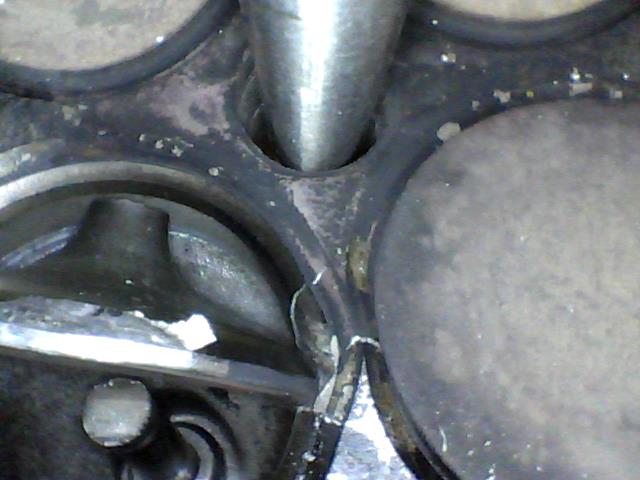Sale ends todayGet 30% off any course (excluding packages)
Ends in --- --- ---
Talk about engine building here. New products, tricky questions or showcase your work - If it's engine building related it's welcome here.
Hi, My engine just dropped 2 intake valves on cylinder 4 And I am trying to figure out why .
Build engine with 11mm intake lift cams, dual valve spring and Supertech valve, the engine ran great for approx 2k miles at 17psi .
The retainer is still in place with the spring, I've checked the timing and it was still fine .
Exhaust valve in this cylinder are bent but not dropped! are exhaust valve stronger than intake valve? I would assume both of intake valve that dropped into the cylinder would have destroyed the exhaust valve completely like they did with the pistons .. nothing left lol
I have not checked valve to valve clearance but if this clearance was the issue, I would have that issue a lot sooner isnt it ? not 2k miles later
All other cylinder are in good condition, no bent valve.
The engine has never seen over 7500rpm never money shifted or anything else ..
Please can you tell me if this dirt on the valve is normal ? This is a port injection engine .
Thank you
What was your valve lash set at?
And what was your piston to valve clearance?
With the cam change, did you check Piston to Valve clearance? Does your engine have the Variable Valve Timing? If so, did the piston clearance get checked at max advance / retarded positions?
I have had the stock 2.0 intake valve heads break off after only a few hours, but I rev that engine to 8200 RPM. I think I stopped it sooner.

My money would be on piston to valve clearance, or lack of it.
I would say that it was JUST touching at higher RPM (or cam advance) hence it lasted a while. The end of the valve stem looks like it got weakened and then it snapped off.
@David Ferguson, may I ask what bore scope you are using. I have a couple but neither do a full 180deg turn like that one appears to.
I captured that picture with this one:
http://www.vividia-tech.com/va-400-usb.html
It's lens eventually got cloudy and it wouldn't show clear images like that one. My new one is this (for about 1/3rd the price!):
https://www.amazon.com/dp/B08VDZBT65?psc=1&ref=ppx_yo2ov_dt_b_product_details
@Jordy. It seems some of the duratecs do have a habit of dropping valves. I dont know them well enough to know if the 2.3 is related to the 2.0 & 2.5 but I've had customers 2.0 drop one on me, and it sounds like David has seen it more than once too. Here is a link to the last time this subject came up: https://www.hpacademy.com/forum/general-tuning-discussion/show/piston-disintegrated-failure-analysis
@David, thanks for the camera info. I have one similar to your 2nd one but without the side camera. On mine you have to screw a mirror attachment on the end to see perpendicular - and that is pretty useless with the focal length being too long to focus on say valves or chamber. Does that one work ok for this sort of work?
There may have been other issues, such as grazing the pistons with the valves on full advance, but "Supertech" valves have a bad reputation for failing at that exact point, even without V2P issues. Many builders, on strip down, have found other valves with fatigue cracks in the same area.
NOTE, this may not directly be a 'Supertech" problem, and the high numbers may be due to their popularity resulting in a disproportionate number of failures.
NOTE 2, this is usually associated with "dual" or "double" springs - as such, I strongly suspect people are just installing them and not checking the installed length, or seat force but that needs $$$ tools. If the installed length is to great, not only the nose force is reduced, but critically because the force close to the seat is lower, there is an increased probability of loss of valve control and the valve physically bouncing on the seat - true valve bounce!
This puts some very high tensile spikes through that transition point, which is the most stressed part of the valve- worse, if the valve doesn't land perfectly straight (they do wave around a bit - there are some very good high speed test videos of this on YT)) it can put tiny bending stresses there as well..
If possible, whenever an engine builder has a similar failure, it may be educational to check the other valve's clearances as if they've closed up At ALL it is probably pointing to the valve head deforming under stress! Remember, any valve train wear will open up the clearances, the ONLY ways they can close is if the valve is deforming and/or the much less common issue of excessive wear of the valve/seat! It's also something to bear in mind if doing regular clearance checks.
Ah I skipped over the statement that it has performance valves. Probably makes my comment irrelevant sorry.
Forgot, no, that sort of deposit isn't something I'd regard as "normal", far from it in fact!
It looks like a build up of carbonised oil deposits from excessive valve stem/guide clearances and/or faulty valve stem seals.You may get a better idea where the oil(?) came from if you check the ports, and if the spark plugs have more deposit on one side than the other.
Last head I stripped was the 'shopping basket' (basically 'retired') and with ~160k miles there was a very light dusting of carbon on the valves, more a discolouration than deposit. Same with the ports and piston top - I was rather pleasantly surprised, TBH.
